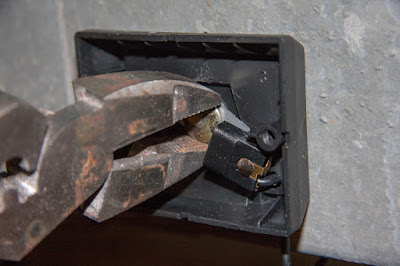As I near the completion of the Utility project, my remaining "to-do" list seems to be getting longer... not shorter.
Part of that is due to the bilge pump I've yet to install. The pump itself must be mounted to the hull. There's the switch that needs to be wired. The switch must be mounted, which means I need to build a place to mount it. The pump, of course, requires a battery (which fortunately I do have). Still, I have to build a mount for the battery. I have actually been working on that the last few days, but no photos just yet. That'll have to wait for another post.
In the meantime, I can celebrate one more layer of varnish on the deck... and complain a little about the trailer lights.
The Varnish
 |
| Sanding the third coat of varnish |
 |
| More sanding... |
 |
| More sanding... |
 |
| 4th coat of varnish! |
The Trailer Saga Continues
In the last post, I mentioned that I was unable to install the new bow roller. That is because the center hole was too small for the existing pin that holds it to the bracket. I had assumed I could simply buy a new pin. That turned out to be less easy than I wanted it to be.
Did I mention that I have an OLD trailer? According to the manufacturer's records, the trailer is as old as I am... a 1970 model. It's a darn well-made trailer. And apparently, that was back in the day when a 5/8" diameter pin was manufactured to 5/8" diameter.
The new bow roller was "labeled" as 5/8".... and apparently made for a new-fangled 5/8" pin that is manufactured to something less than 5/8" diameter. I can only assume, because in spite of the plethora of rollers to be purchased, there was not one pin to be found. At least, not before I finally realized that a smaller diameter pin would also mean I'd have to replace or modify the mounting bracket as well.
That's when I remembered that I have a perfectly functional drill press.
So, I bored out the hole, and the old pin fit just fine.
The next problem was the fact that the new bow roller was more narrow than the old mounting bracket. No problem. An old hole saw from a doorknob mounting kit, a piece of leftover vertical-grain pine... and next thing you know, I had a couple of wooden washers / spacers that work just fine.
The Trailer Lights
Now... on to complaining about the trailer lights.
In the last post, I had facetiously remarked about my daughter's superb tape job on the side marker light that had fallen off on it's maiden voyage.
When I started pulling the tape off... (and pulling... and pulling... and pulling...) I realized just how much tape she had used.
In short order, I came to regard her tape job as a notable structural upgrade from the originally-supplied mounting hardware.
The lighting kit I had purchased is an Optronics submersible trailer light kit from Cabela's. Truthfully, it was an easy-to-install kit that I'm happy with overall. The side marker lights, however, only have one mounting bolt each... not two. That means the lights can be more prone to rotating. Maybe not a major issue... but two bolts would have been preferable.
The mounting hardware included a small lock washer and nut, made from some pretty cheap-looking material. I decided to re-attach each light with stainless steel lock nuts and fender washers, since the original washers were a bit small in relation to the mounting hole in the trailer.
 |
| Fender washer and lock nut |
However, shortly after I began threading on the first lock nut, the entire bolt began to rotate inside the light assembly. The original had used a lock washer, because the bolt is not fixed into place inside the light assembly. The lock nut requires more torque.... too much for the bolt to stay in place.
So, I removed the amber lens to see what I could do.
I could see the rotating bolt head. However, I couldn't grip it with pliers without risking breaking the light bulb.
Fortunately, the bulb could simply be pulled free from its mounting clip.
Then, I could grip the bolt head with a pair of pliers and hold it in place while I finished tightening the lock nut.
With the light assembly firmly in place, I plugged the bulbs back in and re-attached the amber lenses... and hoped nothing went wrong in the process.
So, I plugged the trailer lights back up to the car...
...and thankfully, everything worked just fine.









































